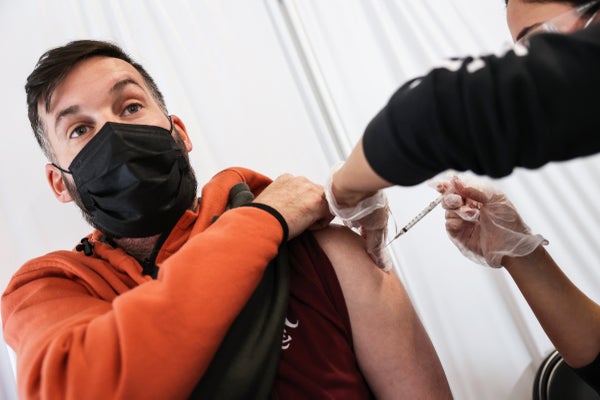Recently, the U.S. Food and Drug Administration authorized COVID booster shots for all adults who have received their initial set of vaccinations. The CDC followed by strengthening their recommendation for all eligible people 18 years of age and older to get vaccinated.
Most scientists knew when COVID-19 vaccines were first authorized that we would need at least one additional shot to complete the primary series, known as a prime-boost strategy. This is despite the vaccines’ outstanding initial efficacy. This sort of boost is required for many infectious disease vaccines to generate longer-lasting immunity. With holidays coming up, the emergence of new variants such as Omicron, and rising rates of infections in vaccinated individuals, it’s important to get boosters so we can move toward ending this pandemic.
Ending the pandemic means that approximately 90 percent of the global population will likely need to be immune to SARS CoV-2, the virus that causes COVID-19. Unfortunately, many people outside the U.S. have not even received their first vaccines. However, to ensure that the pandemic is not prolonged and to protect our already overburdened medical systems, boosters in nations with more established vaccine programs should be rolled out at the same time that global distribution for first doses is increased.
On supporting science journalism
If you're enjoying this article, consider supporting our award-winning journalism by subscribing. By purchasing a subscription you are helping to ensure the future of impactful stories about the discoveries and ideas shaping our world today.
Booster shots are not a sign that vaccines aren’t working—but rather that our immune system needs repeated, well-timed exposures, especially for new diseases, to produce longer-lasting memory so that we are protected when future exposures occur.
Now that we know that we will need boosters, the major outstanding issue for scientific, medical and public health communities has been understanding who needs them and when. The answers began to appear in June of this year, when countries that had initiated large-scale vaccine campaigns in late 2020 started seeing new surges in infections.
Multiple studies throughout the world emerged, showing rates of infections, hospitalizations and deaths rising among vaccinated people. These studies included countries such as Israel and the United Kingdom, where approximately 50 percent of adults were fully vaccinated by May and July 2021, respectively. Despite these numbers, hospitals started to fill again, not just with unvaccinated people, but also with people who had been vaccinated. In some countries, close to 60 percent of hospitalized people had been vaccinated against COVID-19. The vaccines’ ability to protect against symptomatic COVID-19 dropped from 70–95 percent to 30–70 percent, depending on the vaccine. In addition, studies in Israel showed that in vaccinated people aged 16 and older, protection against infection fell.
Waning protection first became apparent in the people over age 65, since these were the first people to be vaccinated, but it’s now been shown in all age groups. Compared to people who were vaccinated earlier, the rate of infection in recently vaccinated people was about 50 percent lower, including against the more contagious delta variant.
By the end of the summer it became clear that to complete the primary series of COVID vaccines people would need a third shot, or a booster, to maintain that higher level of protection against the virus over time, particularly against the new strains. Studies measuring the level of SARS CoV-2 antibodies in people who had been vaccinated suggested people would need to get boosters 4–6 months after the priming vaccine regimen.
Countries that had started vaccinating before the U.S. began initiating booster doses and these boosters appeared to be effective. In Israel, within two weeks of the initiation of boosters for all who were eligible, COVID case rates began to decline, finally reaching approximately 2 percent around 6 weeks later—the nation’s level of infection after the initial round of vaccines. Other studies showed that boosters increased antibody levels; one month after a booster dose of either the Pfizer-BioNTech vaccine or the Moderna vaccine, people’s antibody titers were approximately two to three times higher than titers after their second doses. Further, vaccine efficacy increased from 73 percent after one dose to 94 percent after two doses of the Janssen vaccine.
With one of us (Maldonado) having experience in leading clinical trials of COVID and respiratory syncytial virus vaccines for Pfizer, we are among the many clinicians and scientists who have long believed that boosters are not controversial; rather they align with what scientists know about the immune system and the responses to many vaccines: people need both the initial shots and boosters to be sustainably protected. This prime-boosting strategy is employed with most current vaccines, including 13 of the 17 routine childhood vaccines. The only exceptions are the live viral vaccines against measles, mumps, rubella and chicken pox, for which second doses are primarily used to produce immunity among those who did not respond to the first dose. The only variation in vaccine regimens is when each of the boosters are needed as part of the primary series; typically this is months, as in the case of COVID-19 and hepatitis B. Some vaccines require continued boosting years after the primary series, as in the case of tetanus. Whether we will need additional boosters in the future for COVID-19 is unknown, and scientists around the world will be tracking immunity over time to help make this decision.
We have achieved a remarkable feat: science has led to the rapid development of safe and effective vaccines within a year of SARS-CoV-2 emerging in humans. Together with public health measures, vaccines can mitigate the impacts of this historic pandemic. It is now imperative that we take the next steps to ensure that our global community is fully vaccinated, which include first doses, but also, when it’s time, boosters. Doing so will change the trajectory of this pandemic by creating a more sustained response to this ubiquitous virus.
